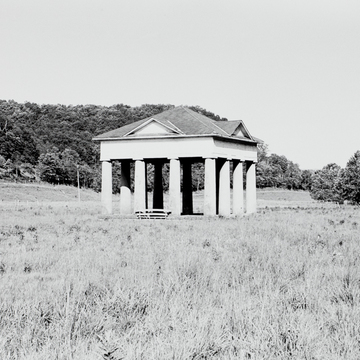Architecture, at least in America, rarely gets more poignant and evocative than it does here. Several of West Virginia's country roads lead to a large cow pasture that lies in a flat, open vale encircled by tree-covered hills. A Doric temple, archaic in its proportions and sparse detail, stands isolated in the pasture, its twelve plastered brick columns supporting a frame entablature and hipped roof, with a tiny gable at the center of each side. Is this West Virginia or ancient Greece?
It's the springhouse of Blue Sulphur Springs, sole remnant of one of antebellum Virginia's most popular and extensive spas. Only a single, tantalizing reference to its likely designer is known to exist. In August 1836 Peregrine Prolix (Philip Houlbrooke Nicklin's nom de plume) and “five Baltimoreans” journeyed in a coach-and-four from White Sulphur to Blue Sulphur during a summer pilgrimage to the various springs. “One of our party,” he reported in Letters Descriptive of the Virginia Springs (1837), “who has a fine taste in drawing, left a beautiful design for a building to cover the spring; it is to be a Greek square, presenting four fluted columns surmounted by an entablature and pediment on every side.” John H. B. Latrobe comes to mind as the most likely suspect. A Baltimorean, he often frequented White Sulphur Springs during the 1830s, where he designed seven Greek Revival cottages, known collectively as Baltimore Row. A son of architect Benjamin Henry Latrobe, he was an engineer by profession but admitted that “from time to time [he] dabbled somewhat in architecture.” A pyramidal roof with a small central gable on each side has replaced the original pediments, and the columns are now covered with a smooth coat of rendering, but it is the overall effect and the setting, rather than details or architectural niceties, that count here.
Blue Sulphur Springs fell from favor in the 1850s, probably in part because of its isolation. In 1859 the Baptist church bought the spa and established Allegheny College in its buildings. A fire in 1860 destroyed the main building, and although a portion was rebuilt, the school closed in 1861 with the outbreak of the Civil War. In 1864 Union troops burned the complex, except for the springhouse, to prevent Confederates from using the buildings.
Other area spas boast more tangible vestiges of their antebellum splendor, but if one wants to come close to the ghosts of the past, this is the place. The currently deserted landscape could hardly be in greater contrast to the once busy scene described in words and pictures.

